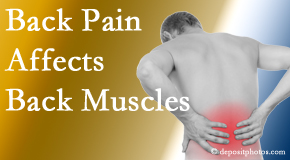Auburn Back Muscles Affected By Back Pain
The spine is supported by many muscles. Back pain and degenerative spine disorders impact those muscles. Chiropractors like yours at Dr. Le's Chiropractic & Wellness, L.L.C. address both the degenerative spinal pain condition and the related degenerated spine muscles. Auburn chiropractic back pain treatment plans incorporate pain-relieving approaches for both the spine and its musculature.
BACK PAIN AND MUSCLES’ RESPONSES
Back pain impacts back muscles. Different Auburn back pain conditions affect different Auburn back muscles, too. Paraspinal muscles present varied responses to spinal degenerative conditions. Alterations in the lumbar spine paraspinal muscles of low back pain patients have been explained. Wasting of the multifidus muscles in patients with back pain, lumbar radiculopathy, and lumbar degenerative kyphosis are particularly documented. Increased fat infiltration of the multifidus muscle is also present in patients with lumbar radiculopathy and lumbar degenerative kyphosis. (1) In a study of 78 patients with either degenerative lumbar spondylolisthesis or degenerative lumbar kyphosis, researchers described these degenerative muscle patterns. The multifidus muscle is seen as the stabilizer of the lumbar spine segments while the erector spinae muscles tend to be referred to as the stabilizers of spinal sagittal balance. Multifidus muscle degeneration was more significant in the patients with degenerative lumbar spondylolisthesis. Erector spinae degeneration was more significant in the degenerative lumbar kyphosis patients as well as more directly correlated with the severity of spinal kyphosis curvature. (2) Continuous chronic low back pain sufferers as compared to non-continuous and recurrent low back pain sufferers were documented to have higher EMG activity in erector spinae and multifidus muscles in extension. (3) Your Auburn chiropractor at Dr. Le's Chiropractic & Wellness, L.L.C. takes great care in addressing these differences.
BACK PAIN AND BACK MUSCLES: STABILITY
Dr. Le's Chiropractic & Wellness, L.L.C. also notes back pain and muscle response on spinal stability. Researchers explained that chronic low back pain impairs spinal stability of its sufferers. In examining the activation patterns of the latissimus dorsi, gluteus maximus, and upward scapular rotation muscles of chronic LBP patients, researchers discovered a significant increase in upward scapular rotation in all shoulder abduction positions on both sides. The left side was more affected than the right. Further, they found increased latissimus dorsi muscle activities and reduced gluteus maximus activities in chronic low back pain. (4) Spinal manipulation is described as stimulating transient physiological responses of which paraspinal muscle activity and muscle spindle responses are included. (5) Your Auburn chiropractor will keep these in mind when treating your spine as well as in setting exercises to address weaknesses.
CONTACT Dr. Le's Chiropractic & Wellness, L.L.C.
Listen to this PODCAST with Dr. Paulette Hugulet on The Back Doctors Podcast with Dr. Michael Johnson. She discusses her implementation of spinal manipulation, namely the Cox® Technic System of Spinal Pain Management, for a 77-year-old patient to decrease pain and better her muscle function and strength.

